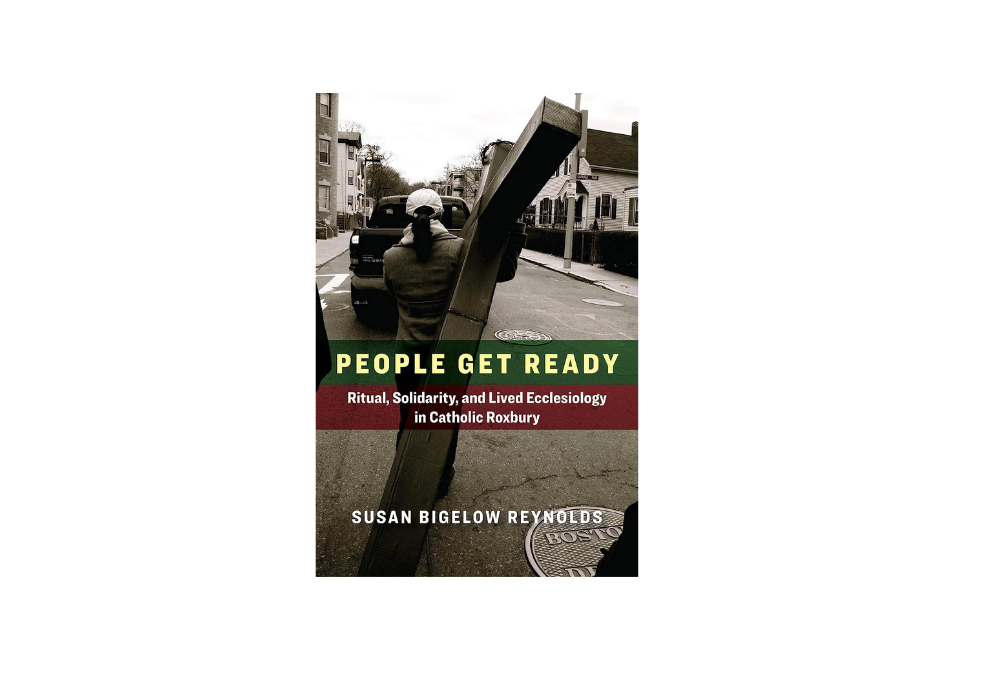
(NCR/Courtesy of Fordham University Press)
What a blessing it would be if every parish had a sympathetic and penetrating chronicler like Susan Bigelow Reynolds, whose book People Get Ready: Ritual, Solidarity, and Lived Ecclesiology in Catholic Roxbury examines St. Mary of the Angels Parish in that Boston neighborhood.
Reynolds, who teaches theology at Emory University in Atlanta, would probably counter that observation with a different one: What a blessing it would be if every parish had the sense of shared community and commitment, of solidarity, as the people who belong to this small church in Roxbury's Egleston Square. Perhaps, better to say, that the church belongs to them rather than that they belong to it.
Like many Boston churches, St. Mary's was built, actually half-built, along the transit lines connecting Roxbury with downtown, but it was a small, territorial parish, with two ethnic parishes, one German and one Polish, nearby. Soon, Jewish immigrants came to the neighborhood. St. Mary's parishioners worshiped first in the railway car barn, and in 1908 moved to the basement of the church. The funds and the families to build the church above never materialized, and when Reynolds arrived in 2011, while studying at Boston College, the congregation still worshiped in the basement church.
The lens Reynolds applies is ethnographic and, as she explains the history of the church, the choice of lens seems obvious. "St. Mary of the Angels is a parish on and of the margins," Reynolds writes. "For more than a century, its small boundaries have encompassed some of Boston's most consequential religious and racial borderlines."

Susan Bigelow Reynolds' "People Get Ready: Ritual, Solidarity, and Lived Ecclesiology in Catholic Roxbury" examines St. Mary of the Angels Parish in that Boston neighborhood. (Courtesy of Candler School of Theology, Emory University)
She goes on to note that, "In an otherwise highly segregated city and church, St. Mary's had become a hybrid parish formed over time by successive migrations." Some migrated from other countries, others migrated from parishes across town that had become unwelcoming. A few migrated from other denominations: Before World War II, many Black people settled in Roxbury as two Black Protestant churches opened in 1926 and 1939. The 1960s saw an influx of migrants from the Caribbean. By 1986, the pastor reported to the archdiocese that the parish served "five hundred to six hundred people representing forty-three different countries of origin."
The fact that migration played a part in bringing so many parishioners to the basement church made it an ideal candidate to embrace and live out the image of the church as the pilgrim people of God, articulated at Vatican II. Reynolds further argues that "recovering the ecclesiological significance of difference requires centering reflection precisely at the site of difference — both the sources of rupture and the moments of embrace."
Reynolds chronicles the unsuccessful effort to revitalize "inner-city" ministry and evangelization launched by Boston's legendary Cardinal Richard Cushing, a great champion of the Civil Rights Movement, in the 1960s. The top-down effort came to naught, and Reynolds contrasts that want of success with the seemingly less ambitious, but ultimately more fruitful, establishment of a parish council in 1969. "Seizing the postconciliar ethos of openness and collaboration, laity leaned hard into their newfound power in order to place their struggling parish into a relationship of costly solidarity with the increasingly marginalized community it served," Reynolds observes.
Two early parish council initiatives caused worry within the archdiocesan chancery but ultimately received Cushing's approbation: the transfer of parish funds to a local, community bank, and gaining a dispensation to hold vigil Masses on Saturday so that the working people in the parish could enjoy their one day of rest with their families. These early exercises in lay leadership would continue and blossom, culminating in the successful effort to resist closing the parish in 2004.
'The dynamics that have shaped St. Mary's for a century are today transforming the entire landscape of U.S. Catholicism.'
—Susan Bigelow Reynolds
Reynolds' chapter on the neighborhood Way of the Cross displays her passion for the particularities of the story she is telling, as well as her capacity for analysis and fine prose. "Taking a different route every year, the procession invariably crosses neighborhood boundaries, gang territories, and parish lines as it weaves together the stations into a single path, as though embroidering a new map on top of an existing one," she writes.
The ritual, which stops at the sites of recent tragedies in the community, also does more than fashion a new divinely touched map over Roxbury's sufferings. "Resisting interpretations of ritual as a form of narrow meaning-making or as the bearer of a singular, all-encompassing ecclesial culture, I contend instead that the Roxbury Way of the Cross can be understood as a form of practical action that affirms solidarity in difference." Anecdotes demonstrate how the various individuals within the parish negotiate their differences while respecting them.
Later chapters discuss other ways ritual "affirms solidarity in difference." The parish council meetings are understood as rituals in themselves, starting with the reading of the parish mission statement in both English and Spanish. So, too, is the jumbled seating on Palm Sunday when no one ends up in their usual pew. The welcome extended during the parish announcements is another: "We want to begin by welcoming those who are here for the first time, or those who have been away for a while and returned," which Reynolds notes is the first time she has heard a welcome extended to fallen away Catholics, despite all the fretting about their departure! The regular efforts to arrange transportation for elderly parishioners, the potluck meals, the to-and-fro in the parish house, all attest to a vibrancy most parishes would envy.
It is impossible not to recognize how remarkable a parish St. Mary of the Angels is. It is also hard not to see how this parish, unlike most, successfully fought off the 2004 attempt to close it as part of the diocese-wide restructuring, arguing that the little church was an indispensable part of the neighborhood. If there is a better illustration of the changed self-understanding of the church implicit in Gaudium et spes, the Vatican II document on the church in the modern world, I do not know it.
Reynolds sees in St. Mary of the Angels not only an exceptional parish but a paradigmatic one.
"The dynamics that have shaped St. Mary's for a century are today transforming the entire landscape of U.S. Catholicism," she writes. "Among these are new and expanded contexts of migration, sweeping regional shifts in parish growth and decline, an ever-increasing need for lay leadership, limited resources, deep institutional mistrust and betrayal propelled by the clergy sex abuse crisis, and mounting calls for racial and economic justice."
Advertisement
But there is one regard in which the Roxbury parish is exceptional that will limit the degree to which it can be paradigmatic. For a variety of reasons and in a variety of ways, St. Mary of the Angels is an intentional community. Yet, it is the genius of Catholicism to make a home for the B+ Catholics, and the C+ Catholics too, for the slackers, for those whose sense of community lies elsewhere but who still wish to find some communion with God and find it at Mass. A parish like St. Mary's is likely too much for them. Every major city has a few parishes like St. Mary's, refined in the fire of tribulations and overflowing with a life-giving spirit. They stand as a critique of the less-committed expressions of the faith. But they are exceptional.
In each chapter, interviews with parishioners bring the story alive and Reynolds weaves the whole into a narrative that is both readable and serviceable. After all, she is a theologian, not an historian, and this story has a purpose.
Solidarity is, for Reynolds, the great untapped ecclesiological principle of Vatican II. Yes, yes, solidarity has shaped our social ethics, and even our Christian anthropology. But, in her first chapter, she argues that the post-conciliar emphasis on communion ecclesiology undervalues the significance of difference.
"I argue that Vatican II laid the groundwork for an understanding of the parish as a school of solidarity," Reynolds writes. "Yet as magisterial attention shifted to emphasize communion ecclesiology as the predominant interpretation of Vatican II's ecclesiology, the ecclesiological implications of the council's vision of solidarity have gone largely overlooked."
She criticizes communion ecclesiology specifically for "ignoring the stark asymmetries of power that definitively shape the liturgical, sacramental and social life of a parish." The "communion paradigm ultimately underwrites ecclesial colorblindness and renders unclear the mission of the local church with respect to racial justice."
If so, and Reynolds makes a good case, this is a serious flaw in communion ecclesiology, and one it must address. I am not sure it is a fatal flaw, nor that the ethnographic perspective she employs does not also leave out integral aspects of a viable ecclesiology.
But here is the thing. This is a thoughtful, insightful book. It is not given to exaggeration, nor to a facile adoption of a "prophetic stance" that corresponds little with the stances taken by prophets in Scripture and more to the academic fads of the day. I could quibble with this observation or that, but none of the quibbles rise to an indictment.
I venture the hope that this book will also become seminal, that is, it will start a dialogue and debate between those theologians who, like Reynolds, employ ethnographic analysis and those theologians who cling to the communion ecclesiology that has so shaped the post-conciliar magisterium. Certainly, as Reynolds argues, the idea of an ecclesiology of solidarity could yield important correctives for a U.S. church that has difficulty resisting the cultural forces of the ambient culture, especially its comprehensive libertarianism from the boardroom to the bedroom.
American Catholic theology is in a state of crisis, and we need more theologians like Reynolds who engage the arguments of those with whom they disagree, do so respectfully, and put forward their own arguments with clarity and charity both. This is an excellent book and it should be read by a wide audience.







